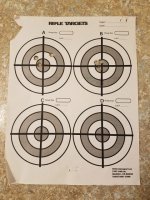I think a couple of points need to be cleared up.
A rough bore has nothign to do with how it shoots, it may not clean easy, it may build some copper (usually not a lot), but it shoots fine.
As button rifling is a brute force method, there is no way its not going to leave a roguish barrel (it also induces stresses)
The stresses can be (and are) relieved more or less successfully. Probably the less part is why some never can be made to shoot.
Lapping cleans up the mess, after market barrel makers do some or a lot (Shilen is good, Lother Walther is good, Criterion is reported to be good) X Caliber is better than Savage factory but not as good as the others.
Savage factory still straightens crooked barrels (it works fine to not so much). Again a possible source of a bad barrel. You can tell those by how badly they bore sight.
After market guys don't mess with a crooked barrel, its scrap (one reasons costs are higher)
Savage does not sell factory barrels on the open market.
Cut rifles are better as they do not induce stress, the top barrel makers (Lilja, Bartlein) use that method. I believe it still needs clean up.
Hammer Forged makes very smooth barrels. It also induces huge stress. They used to be mediocre shooters.
If its loose mandrel (no finishing ) then its not the greatest shooter (think Military M16 barrels). Only the big mfgs use that (costly setup). Remington uses hammer forged, I believe Ruger does.
CZ I believe hammer forges then laps to a final size.
I don't know if Remington etc uses tighter mandrel tolerances but they have gotten pretty decent shooters now.
If the stress is not relieved in the relief process, you will get a wild shooting barrel.
A rough bore has nothign to do with how it shoots, it may not clean easy, it may build some copper (usually not a lot), but it shoots fine.
As button rifling is a brute force method, there is no way its not going to leave a roguish barrel (it also induces stresses)
The stresses can be (and are) relieved more or less successfully. Probably the less part is why some never can be made to shoot.
Lapping cleans up the mess, after market barrel makers do some or a lot (Shilen is good, Lother Walther is good, Criterion is reported to be good) X Caliber is better than Savage factory but not as good as the others.
Savage factory still straightens crooked barrels (it works fine to not so much). Again a possible source of a bad barrel. You can tell those by how badly they bore sight.
After market guys don't mess with a crooked barrel, its scrap (one reasons costs are higher)
Savage does not sell factory barrels on the open market.
Cut rifles are better as they do not induce stress, the top barrel makers (Lilja, Bartlein) use that method. I believe it still needs clean up.
Hammer Forged makes very smooth barrels. It also induces huge stress. They used to be mediocre shooters.
If its loose mandrel (no finishing ) then its not the greatest shooter (think Military M16 barrels). Only the big mfgs use that (costly setup). Remington uses hammer forged, I believe Ruger does.
CZ I believe hammer forges then laps to a final size.
I don't know if Remington etc uses tighter mandrel tolerances but they have gotten pretty decent shooters now.
If the stress is not relieved in the relief process, you will get a wild shooting barrel.

